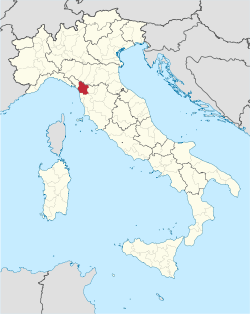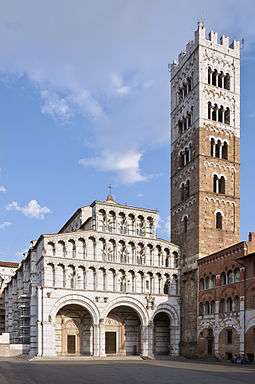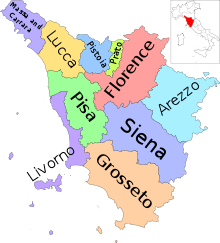Province of Lucca
The Province of Lucca (Italian: Provincia di Lucca) is a province in the Tuscany region of Italy. Its capital is the city of Lucca.
Province of Lucca | |
|---|---|
Laghetti di Compione in Appennino Tosco-Emiliano National Park | |
 Map highlighting the location of the province of Lucca within the Tuscany region of Italy | |
| Country | |
| Region | Tuscany |
| Capital(s) | Lucca |
| Comuni | 33 |
| Government | |
| • President | Luca Menesini |
| Area | |
| • Total | 1,773 km2 (685 sq mi) |
| Population (31 March 2017) | |
| • Total | 390,025 |
| • Density | 220/km2 (570/sq mi) |
| Time zone | UTC+1 (CET) |
| • Summer (DST) | UTC+2 (CEST) |
| Postal code | 55011 - 55110 |
| Telephone prefix | 0583 and 0584 |
| Vehicle registration | LU |
| ISTAT | 046 |
| Website | Official website |
It has an area of 1,773 square kilometres (685 sq mi) and a total population of about 390,000. There are 33 comuni (singular: comune) in the province.[1]
Geography
Situated in northwestern coastal Italy, within Tuscany, Lucca borders the Tyrrhenian Sea to the west, the provinces of Massa e Carrara to the northwest, Pisa to the south, Pistoia to the north-east and Firenze to the east. To the north it abuts the region of Emilia-Romagna (Provinces of Reggio Emilia and Province of Modena). Access to the Tyrrhenian Sea is through municipalities such as Torre del Lago, Viareggio, and Forte dei Marmi. It is divided into four areas; Piana di Lucca, Versilia, Media Valle del Serchio and Garfagnana.[2] Versilia is known for its extensive beaches, and there are coastal dunes and wetlands in the Migliarino-San Rossore-Massaciuccoli Natural Park. The principal resorts of the province are located at Viareggio, Lido di Camaiore, Pietrasanta and Forte dei Marmi. Garfagnana is known for its wooded hills and olive trees.[3]
Lago di Massaciuccoli is a lake with a surface area of 6.9 square kilometres (2.7 sq mi), located mainly in the municipality of Massarosa and partly in Torre del Lago, a civil parish of Viareggio. The lake was known in ancient times as the Fossis Papirianis, a name used in the Tabula Peutingeriana. The composer Giacomo Puccini lived nearby and frequently hunted around the lake; today the Puccini Festival is held there annually in celebration.[4] The springs of Bagni di Lucca, in valley of the Lima River, a tributary of the Serchio are known from the early history of Lucca as the Vicaria di Val di Lima,[5] and Fallopius once claimed that the springs cured his own deafness.
Main sights

Situated along the Via Francigena, a major Medieval pilgrimage route, the province is dotted with castles, abbeys, parish churches and villas such as the Villa Torrigiani and Villa Mansi.[3] Lucca Cathedral, also known as the Duomo of San Martino, was originally built in the 6th century, but was rebuilt in the 11th century in the Romanesque style, consecrated by Alexander II in 1070.[6] It was restored again with Tuscan Gothic influences in the 14th century, when columns of the upper arches were added. The Church of San Frediano, also in the city Lucca, is reputed to be only example of Lombard architecture preserved without notable alteration, although the façade dates to about 1200. The church contains some valuable pieces of art, as does the Mansi Palace and the 14th-century Church of San Francesco, which contains the tomb of the Lucchese poet Giovanni Guidiccioni.[7]
The Case Guinigi and the Guinigi Tower of Lucca is a fine example of remaining medieval architecture in the province; construction began in 1384 to accommodate the wealthy Guinigi family. Paolo Guinigi was a ruler of the town a little later in the early 15th century. 44.25 metres (145.2 ft) high, it was built with sandstone and brick from Matraia and Verrucano from the Monti Pisani. Only one of the original towers remains, and loggia and the porch on the ground floor of it have been shut off.
Also of note is an Aqueduct of Nottolini consisting of 459 arches, constructed between 1823 and 1832.[8]
Government
List of Presidents of the Province of Lucca
| President | Term start | Term end | Party | |
|---|---|---|---|---|
| Giuseppe Bicocchi | 1975 | 1985 | Christian Democracy | |
| Piero Leonardo Andreucci | 1985 | 1990 | Christian Democracy | |
| Franco Antonio Fanucchi | 1990 | 1992[9] | Christian Democracy | |
| Piero Baccelli | 1992 | 1992[9] | Christian Democracy | |
| Pier Giorgio Licheri | 1993 | 1994 | Christian Democracy | |
| Enrico Grabau | 1994 | 1997 | National Alliance | |
| Andrea Tagliasacchi | 1997 | 2001 | Democratic Party of the Left Democrats of the Left | |
| 2001 | 2006 | |||
| Stefano Baccelli | 2006 | 2011 | Democrats of the Left Democratic Party | |
| 2011 | 2015 | |||
| Luca Menesini | 2015 | Incumbent | Democratic Party | |
References
- Official website (in Italian)
- "Territorio" (in Italian). Provincia.lucca.it. Retrieved 29 September 2014.
- "Lucca". Italia.it. Retrieved 29 September 2014.
- Strachan, Donald; Keeling, Stephen (15 June 2011). Frommer's Tuscany, Umbria and Florence With Your Family. John Wiley & Sons. p. 133. ISBN 978-0-470-74988-3.
- "Associazione Vicaria Val di Lima". Contadolucchese.it. Retrieved 29 September 2014.
- Starke, Mariana (1837). Travels in Europe for the Use of Travellers on the Continent Including the Island of Sicily, where the Author Had Never Been Till the Year 1834 by Mariana Starke. John Murray. p. 107.
- Bertelli, Sergio (2004). Trittico: Lucca, Ragusa, Boston : tre città mercantili tra Cinque e Seicento (in Italian). Donzelli Editore. p. 267. ISBN 978-88-7989-909-3.
- Herbermann, Charles George; Pace, Edward Aloysius (1950). The Catholic Encyclopedia: Laprade-Mass. Appleton. p. 405.
- Resigned.
External links
| Wikimedia Commons has media related to Province of Lucca. |
- Official website (in Italian)
